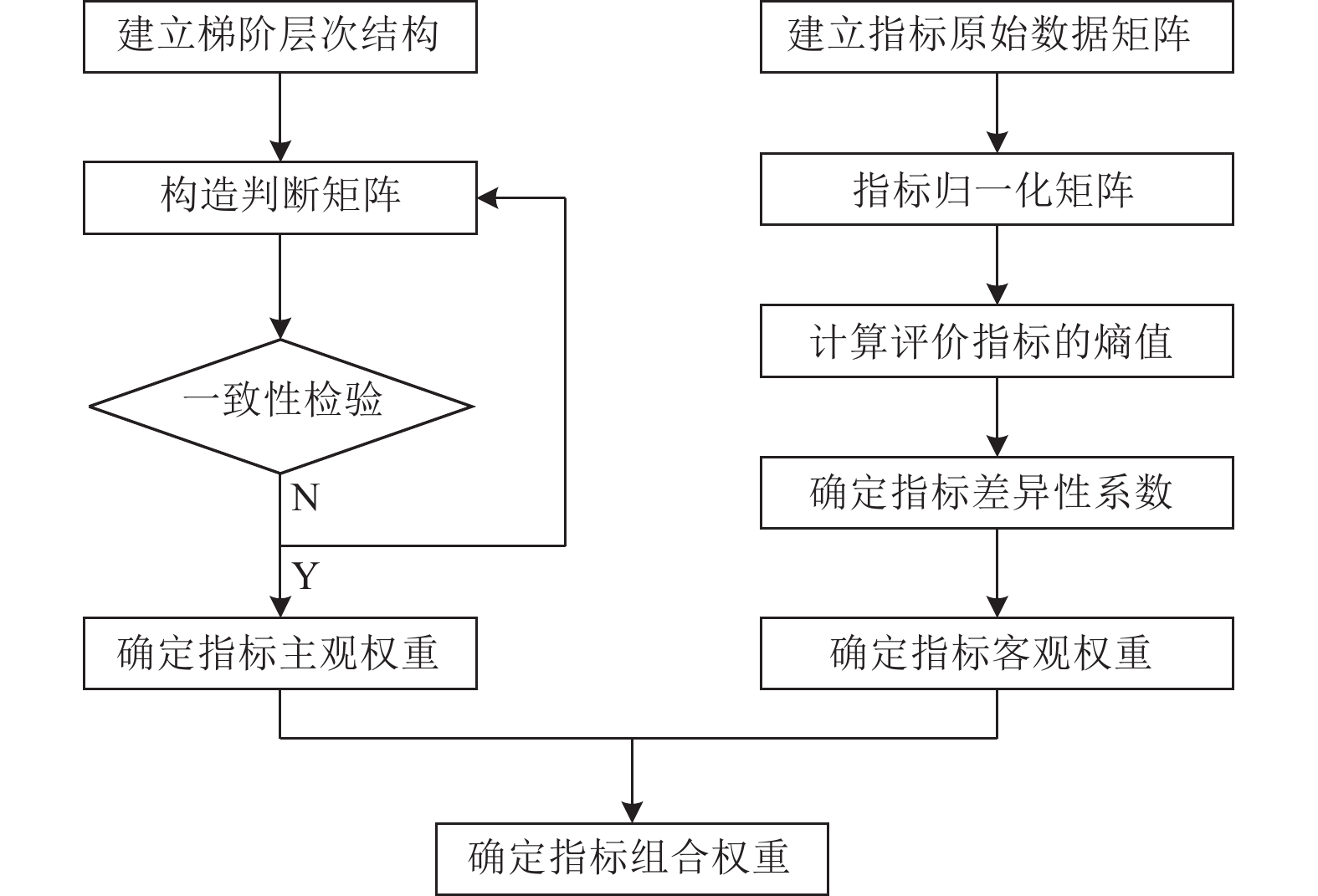Comprehensive Evaluation of Earthquake Sustainability of Existing Tunnels
-
摘要: 为客观评价在役隧道震害综合承灾情况,从隧道震害危险性的压力指标与隧道自身及所处工程环境的承压指标筛选具有代表性、可操作性的分级指标。以隧道承灾系统为研究主体,运用最小偏差法将主、客观权重集合,得到评价指标的组合权重,并利用GRA-TOPSIS法对在役隧道震害综合承灾度进行评价,确定隧道震害承灾情况。选取新疆某3个隧道中的5个区段为研究对象,运用GRA-TOPSIS法构建的隧道震害综合承灾度评价模型确定隧道震害承灾等级,评价结果与现场调查结果趋于一致。对影响承灾度的主要因素进行分析,可为各区段制定适宜的修复策略提供参考。
-
关键词:
- 隧道 /
- 震害 /
- 承灾度 /
- 最小偏差组合赋权 /
- GRA-TOPSIS
Abstract: In order to objectively evaluate the comprehensive hazard-bearing status of the in-service tunnels, an evaluation index system for the comprehensive hazard-bearing degree of the tunnel earthquake damage was constructed from two aspects: the risk of the tunnel earthquake damage and the hazard-bearing capacity of the tunnel itself and its engineering environment. Taking the tunnel disaster bearing system as the main research object, the minimum deviation method is used to collect the subjective and objective weights to obtain the combined weight of the evaluation indicators, and the GRA-TOPSIS method is used to evaluate the comprehensive earthquake disaster bearing degree of the in-service tunnel, and determine the earthquake damage bearing of the tunnel. Five tunnel sections out of three tunnels in Xinjiang were selected as the research objects, and the above-mentioned model was used to determine the earthquake disaster-bearing level of the tunnel. The evaluation results tend to be consistent with the field investigation results. The main factors can provide a reference for formulating appropriate repair strategies for each section. -
表 1 在役隧道震害综合承灾度评价指标体系与分级标准
Table 1. Evaluation index system and grading standard of comprehensive hazard-bearing degree of earthquake damage of in-service tunnels
属性 评价指标 等级 定性描述 定量描述 压力指标 地震峰值加速度C1 Ⅰ 基本烈度<6度 C1<1 Ⅱ 基本烈度6~7度 1≤C1<1.8 Ⅲ 基本烈度7~8度 1.8≤C1<2.6 Ⅳ 基本烈度8~9度 2.6≤C1<3.4 Ⅴ 基本烈度>9度 C1≥3.4 断裂破碎带宽度C2 Ⅰ 无断层 0 Ⅱ 存在落差20 m以下的小规模断层 0<C2≤20 Ⅲ 存在落差20 m以上、30 m以下的较小规模断层 20<C2≤30 Ⅳ 存在落差30 m以上、50 m以下的中等规模断层 30<C2≤50 Ⅴ 存在落差50 m以上的大规模断层 C2>50 岩石风化程度C3 Ⅰ 完好 0 Ⅱ 微风化 0<C3≤25 Ⅲ 中等风化 25<C3≤50 Ⅳ 强风化 50<C3≤75 Ⅴ 全风化 75<C3≤100 地下水情况C4 Ⅰ 无地下水 0 Ⅱ 点滴状地下水 0<C4≤3 Ⅲ 淋雨状地下水 3<C4≤6 Ⅳ 线状地下水 6<C4≤10 Ⅴ 涌流状地下水 10<C4≤12 偏压(地表倾角)C5 Ⅰ <15° C5<15 Ⅱ 15°~30° 15≤C5<30 Ⅲ 30°~45° 30≤C5<45 Ⅳ 45°~60° 45≤C5<60 Ⅴ >60° C5≥60 承压指标 围岩等级C6 Ⅰ 稳定岩石,裂隙不发育或稍发育 C6>4.5 Ⅱ 岩石较新鲜,节理裂隙稍发育 3.5≤C6<4.5 Ⅲ 岩石微风化,地质裂隙发育、部分张开充泥 2.5≤C6<3.5 Ⅳ 软弱结构面多,岩体呈碎石状 1.5≤C6<2.5 Ⅴ 散体 C6<1.5 支护结构与强度C7 Ⅰ 完好 C7>150 Ⅱ 较好 100≤C7<150 Ⅲ 中等 50≤C7<100 Ⅳ 较差 10≤C7<50 Ⅴ 很差 C7<10 隧道埋深C8 Ⅰ 埋深>300 m C8>300 Ⅱ 埋深100~300 m 100<C8≤300 Ⅲ 埋深50~100 m 50<C8≤100 Ⅳ 埋深10~50 m 10<C8≤50 Ⅴ 埋深<10 m C8≤10 承压指标 岩体完整性C9 Ⅰ 完整性好 0.90≤C9<1 Ⅱ 完整性较好 0.75≤C9<0.90 Ⅲ 完整性中等 0.50≤C9<0.75 Ⅳ 完整性较差 0.20≤C9<0.50 Ⅴ 完整性差 0≤C9<0.20 岩石质量C10 Ⅰ 岩石质量好 90<C10≤100 Ⅱ 岩石质量较好 75<C10≤90 Ⅲ 岩石质量中等 50<C10≤75 Ⅳ 岩石质量较差 25<C10≤50 Ⅴ 岩石质量差 C10≤25 路面与附属设施
易损程度C11Ⅰ 完好 0<C11≤2 Ⅱ 无明显受损 2<C11≤4 Ⅲ 受损小于限值 4<C11≤6 Ⅳ 受损接近限值 6<C11≤8 Ⅴ 受损大于限值 8<C11≤10 等效截面积C12 Ⅰ 存在面积<20 m2的小断面 C12<20 Ⅱ 存在面积20~45 m2的较小断面 20≤C12<45 Ⅲ 存在面积45~70 m2的中等断面 45≤C12<70 Ⅳ 存在面积70~120 m2的较大断面 70≤C12<120 Ⅴ 存在面积>120 m2的大断面 C12≥120 表 2 隧道震害数据统计结果
Table 2. Statistical table of tunnel seismic damage data
类别 拟评价项目 C1 /g C2 /m C3 C4 C5 /(°) C6 C7/MPa C8 /m C9 C10 /% C11 C12 /m2 区段1 2.2 0 0 0 8 1.80 75 108 0.80 81 3.0 47.8 区段2 2.2 25 60 8.0 35 1.40 15 30 0.30 22 5.0 47.8 区段3 2.2 20 40 2.0 45 1.60 40 22 0.55 45 6.5 47.8 区段4 2.0 15 35 1.5 20 2.40 55 324 0.80 45 5.5 38.5 区段5 1.9 40 10 2.5 50 2.40 55 331 0.40 41 5.0 23.7 正理想值 0.5 0 0 0 7.5 5.00 175 400 0.95 95 1.0 10.0 负理想值 3.8 60 87.5 11.5 72.5 0.75 5 5 0.10 12.5 9.0 132.5 表 3 评价指标的权重
Table 3. Weights of evaluation indicators
类别 权重 C1 C2 C3 C4 C5 C6 C7 C8 C9 C10 C11 C12 ${\omega '_k}$ 0.188 0.088 0.044 0.118 0.075 0.111 0.057 0.051 0.082 0.061 0.068 0.057 ${\omega ''_k}$ 0.001 0.179 0.224 0.288 0.087 0.004 0.005 0.056 0.074 0.047 0.017 0.018 ${\omega ^ * }$ 0.089 0.137 0.140 0.208 0.082 0.054 0.030 0.053 0.077 0.053 0.041 0.036 表 4 评价指标统计数据的标准化处理
Table 4. Standardized processing of evaluation index statistics
类别 指标 C1 C2 C3 C4 C5 C6 C7 C8 C9 C10 C11 C12 区段1 0.476 1.000 1.000 1.000 0.893 0.327 0.375 0.216 0.800 0.810 0.700 0.670 区段2 0.476 0.643 0.400 0.333 0.533 0.255 0.075 0.060 0.300 0.220 0.500 0.670 区段3 0.476 0.714 0.600 0.833 0.400 0.291 0.200 0.044 0.550 0.450 0.350 0.670 区段4 0.524 0.786 0.650 0.875 0.733 0.436 0.275 0.648 0.800 0.450 0.450 0.734 区段5 0.548 0.429 0.900 0.792 0.333 0.436 0.275 0.662 0.400 0.410 0.500 0.837 正理想值 0.881 1.000 1.000 1.000 0.900 0.909 0.875 0.800 0.950 0.950 0.900 0.931 负理想值 0.095 0.143 0.125 0.042 0.033 0.136 0.025 0.010 0.100 0.125 0.100 0.086 -
鲍学英, 张健, 王起才, 2019. 西北寒旱地区铁路绿色施工等级评价研究. 铁道学报, 41(3): 33—39 doi: 10.3969/j.issn.1001-8360.2019.03.005Bao X. Y. , Zhang J. , Wang Q. C. , 2019. Study on grade evaluation of green railway construction in northwest cold and arid areas. Journal of the China Railway Society, 41(3): 33—39. (in Chinese) doi: 10.3969/j.issn.1001-8360.2019.03.005 冯志泽, 胡政, 何钧等, 1994. 建立城市自然灾害承灾能力指标的思路探讨. 灾害学, (4): 40—44Feng Z. Z. , Hu Z. , He J. , et al. , 1994. A preliminary study on establishing the index of bearing-disaster capability of natural disasters in city. Journal of Catastrophology, (4): 40—44. (in Chinese) 耿萍, 吴川, 唐金良等, 2012. 穿越断层破碎带隧道动力响应特性分析. 岩石力学与工程学报, 31(7): 1406—1413 doi: 10.3969/j.issn.1000-6915.2012.07.013Geng P. , Wu C. , Tang J. L. , et al. , 2012. Analysis of dynamic response properties for tunnel through fault fracture zone. Chinese Journal of Rock Mechanics and Engineering, 31(7): 1406—1413. (in Chinese) doi: 10.3969/j.issn.1000-6915.2012.07.013 何健, 2009. 都汶公路隧道震害评估及修复研究. 成都: 成都理工大学.He J., 2009. Research on the damage evaluation and repair technology of Dujiangyan-WenChuan highway tunnels. Chengdu: Chengdu University of Technology. (in Chinese) 中华人民共和国交通运输部, 2013. JTG B02—2013 公路工程抗震规范. 北京: 人民交通出版社.Ministry of Transport of the People's Republic of China, 2013. JTG B02 -- 2013 Seismic Code for highway engineering. Beijing: People's Communications Press. 中华人民共和国交通运输部, 2015. JTG H12—2015 公路隧道养护技术规范. 北京: 人民交通出版社股份有限公司.Ministry of Transport of the People's Republic of China, 2015. JTG H12—2015 Technical Specification for Maintenance of Highway Tunnels. Beijing: People's Communications Press Co., LTD. 刘东, 龚方华, 付强等, 2017. 基于博弈论赋权的灌溉用水效率GRA-TOPSIS评价模型. 农业机械学报, 48(5): 218—226 doi: 10.6041/j.issn.1000-1298.2017.05.027Liu D. , Gong F. H. , Fu Q. , et al. , 2017. Evaluation model of irrigation water use efficiency based on game theory and GRA-TOPSIS. Transactions of the Chinese Society for Agricultural Machinery, 48(5): 218—226. (in Chinese) doi: 10.6041/j.issn.1000-1298.2017.05.027 孙强强, 薄景山, 孙有为等, 2016. 隧道结构地震反应分析研究现状. 世界地震工程, 32(2): 159—169Sun Q. Q. , Bo J. S. , Sun Y. W. , et al. , 2016. A state-of-the-art review of seismic response analysis of tunnels. World Earthquake Engineering, 32(2): 159—169. (in Chinese) 叶清, 2003. 地震危险性、地震危害性和地震易损性. 福建地震, (2): 38—40Ye Q. , 2003. Seismic risk, seismic hazard and seismic friability. Fujian Seismology, (2): 38—40. (in Chinese) 臧万军, 2017. 汶川地震公路隧道震害规律研究. 现代隧道技术, 54(2): 17—25 doi: 10.13807/j.cnki.mtt.2017.02.003Zang W. J. , 2017. Damage to highway tunnels caused by the Wenchuan earthquake. Modern Tunnelling Technology, 54(2): 17—25. (in Chinese) doi: 10.13807/j.cnki.mtt.2017.02.003 翟强, 顾伟红, 2020. 基于EW-AHP和未确知测度理论的隧道坍塌风险评价. 安全与环境工程, 27(5): 92—97 doi: 10.13578/j.cnki.issn.1671-1556.2020.05.014Zhai Q. , Gu W. H. , 2020. Risk assessment of tunnel collapse by EW-AHP and unascertained measure theory. Safety and Environmental Engineering, 27(5): 92—97. (in Chinese) doi: 10.13578/j.cnki.issn.1671-1556.2020.05.014 周建昆, 吴坚, 2008. 岩石公路隧道塌方风险事故树分析. 地下空间与工程学报, 4(6): 991—998 doi: 10.3969/j.issn.1673-0836.2008.06.001Zhou J. K. , Wu J. , 2008. Fault tree analysis of the collapse risk in rock highway tunnel. Chinese Journal of Underground Space and Engineering, 4(6): 991—998. (in Chinese) doi: 10.3969/j.issn.1673-0836.2008.06.001 朱捷, 曾国伟, 胡国忠等, 2019. 基于事故统计分析的隧道坍塌施工安全风险评估. 公路交通科技(应用技术版), 15(9): 237—240. Hashash Y. M. A. , Hook J. J. , Schmidt B. , et al. , 2001. Seismic design and analysis of underground structures. Tunnelling and Underground Space Technology, 16(4): 247—293. doi: 10.1016/S0886-7798(01)00051-7 Kuesel T. R. , 1969. Earthquake design criteria for subways. Journal of the Structural Division, 95(6): 1213—1231. doi: 10.1061/JSDEAG.0002292 Yashiro K. , Kojima Y. , Shimizu M. , 2007. Historical earthquake damage to tunnels in Japan and case studies of railway tunnels in the 2004 Niigataken-Chuetsu earthquake. Quarterly Report of RTRI, 48(3): 136—141. doi: 10.2219/rtriqr.48.136 -




 下载:
下载:

